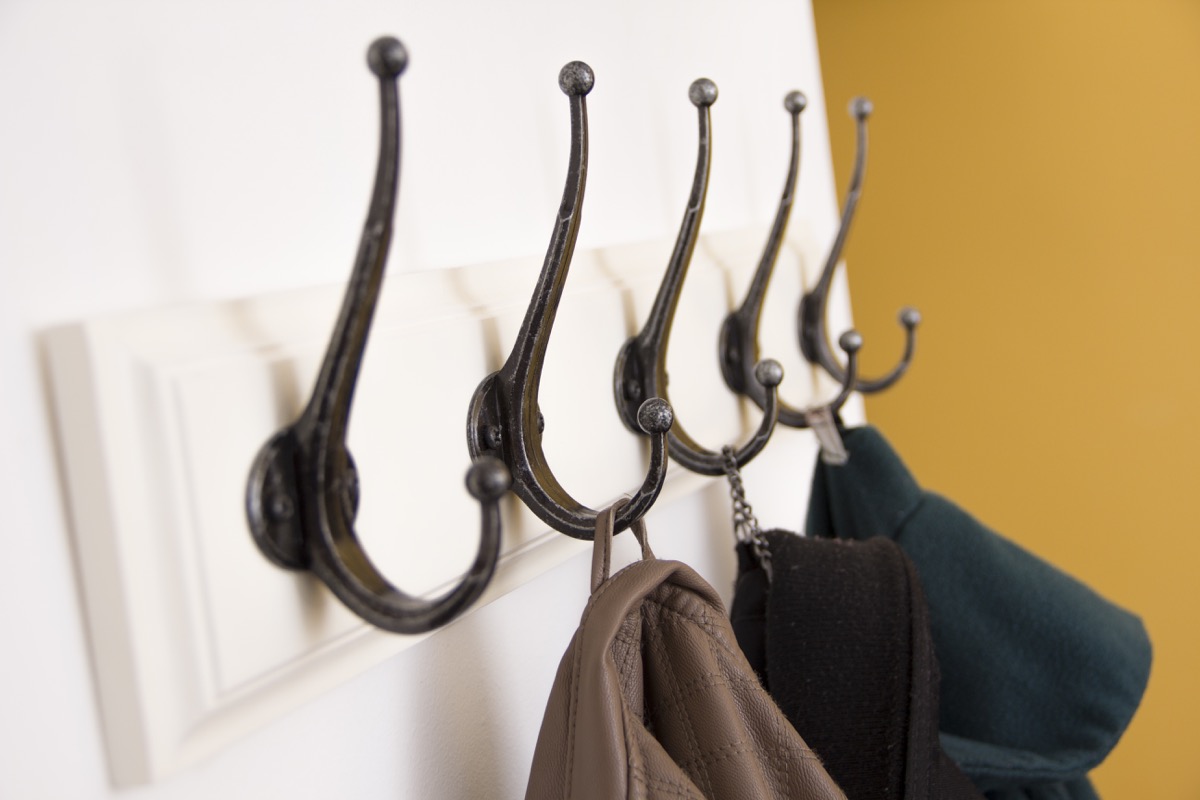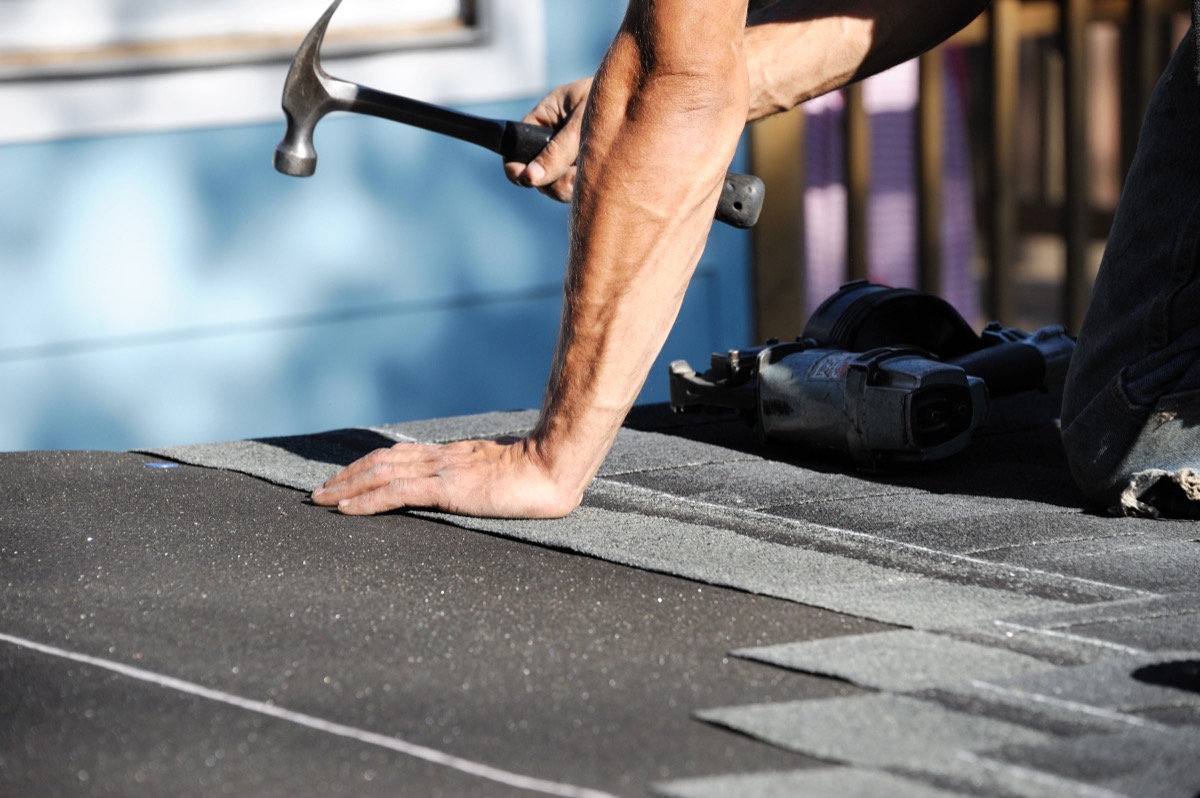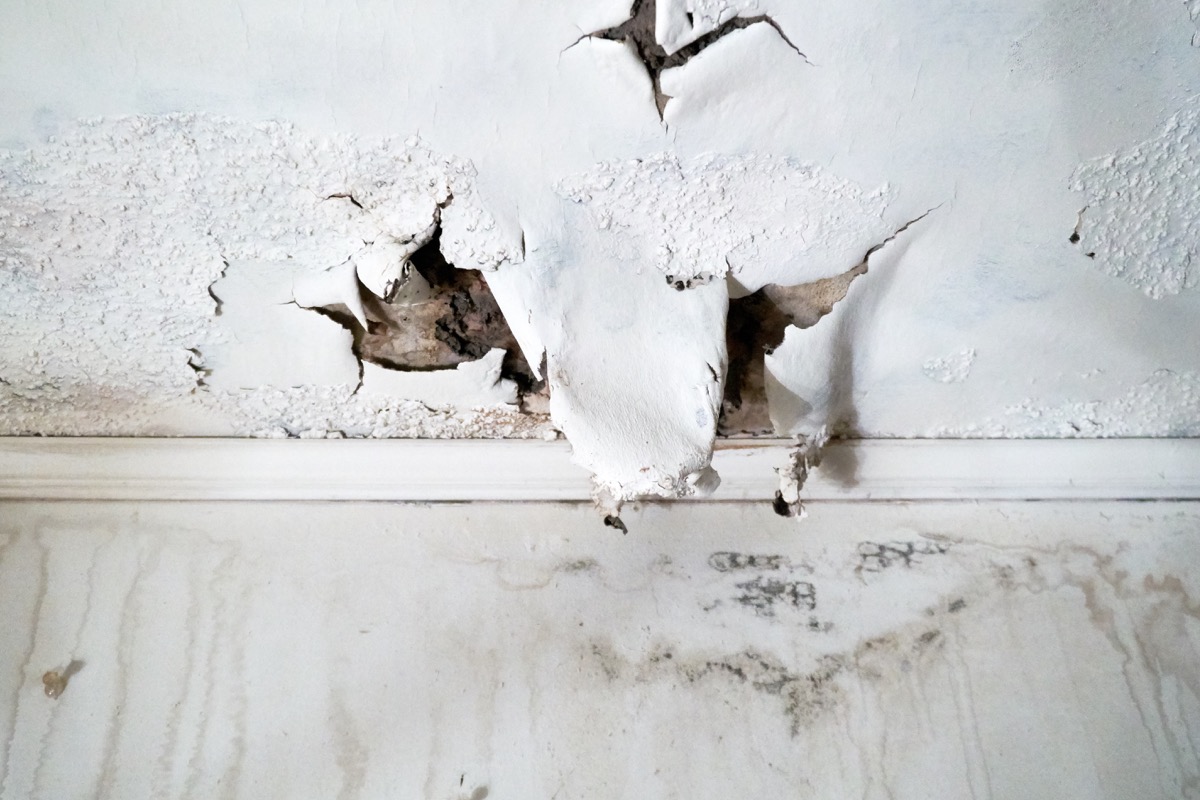20 Ways You’re Using Your Attic All Wrong

It’s the great irony of attics: though their primary purpose is to store old stuff—from family treasures to old clothes to baseball cards to ancient high-school yearbooks—they’re inherently terrible storage containers. The angled ceilings, the awkward geometric spaces, the disgusting lack of drywall or even proper flooring and insulation. It’s no wonder you never go up there—it’s an unsightly terror, where everything is shoved and nothing fits!
So if you’ve got a ghastly world of dust-filled chaos hovering above your head, fret not. With the handy tips that follow, you can give your attic the full makeover it deserves and use it to its full potential, whether that means storing your stuff cleanly and efficiently or even giving yourself a new spare bedroom. The possibilities are endless! And for more attic inspiration: if you’re looking to turn it into something utterly luxurious, don’t miss these 23 Genius Ways to Turn Your Attic into Something Amazing.
1
You’re not making the space safe

Most attics don’t have the space in between the joists—the wood that runs on edge and parallel under the floor to support it—covered around the edges where the roof rafters slope down to the floor. This is where you can see raw insulation sticking out. The problem is, if you step on the insulation here, there’s nothing to support your weight except for the drywall that makes up the ceiling of the room below. Most likely, you’ll fall through.
But if you’re handy, you can simply lay down some plywood (cut to fit by you, or sized at your local home improvement store) and cover such dangerous gaps. For maximum ease, you can buy special plastic decking already the right dimensions (and lighter than plywood) that will easily fit. Drop them in and you’ve increased storage space while making your attic totally safe to walk around in. And for more awesome renovation advice, check out these 23 Affordable Ways to Completely Re-Do Your Home.
2
You’re not creating an easy way to enter

Half of the time, nobody even wants to go up into the attic, especially if the only way to get in is though one of those rickety, pulldown ladder-stairs—which usually have a wimpy, thin metal railing. Then, once you get to the top, you have to clamber out on to the attic floor, and it can get tricky to emerge gracefully into the dusty space. Who wants to go through all that?
Our fix: add a railing around the top of the attic opening, if you’re good with DIY construction and renovations. The rest of us, though, should stick with picking up a ready-made option. The market is loaded with sturdy metal railings—like this one from Home Depot ($26)—that will making hauling yourself up a far less unpleasant task. Simply mount them to the plywood attic floor with some sturdy lag bolts.
3
You’re not taking advantage of hidden storage spaces

Most attics in the average-sized home contain at least a dozen or so trusses, which is carpenter-speak for the little triangular wooden structures you’ll find connecting the joists to the roof rafters. These trusses serve several functions, including supporting the weight of the roof and strengthening the whole home. But if you’re just leaving these trusses sitting there idly on the angled wall of your attic, you’re missing out on an amazing opportunity to install shelving units.
Measure the area between trusses and simply head to your nearest home supply store, and get shelves cut to fit the space, or purchase shelves that specifically to fit into the slots. Simply hang them, and then load them up with storage containers. Look at that: you’re instantly more organized! And for more amazing home upgrades, check out these 7 Amazing Robots Vacuums That Will Make Your Life So Much Easier.
4
You’re putting the wrong items up there

Don’t just toss anything up into your attic—consider the environment that’s created in this top floor space. Few attics are heated or cooled, so they’re extra hot in the summer and frigid in the winter. (Plus, being up high with plenty of airflow can make the space inside a fairly dry environment.)
Such temperature fluctuations and aridness mean you should keep things like upholstered furniture, delicate fabrics, electronics, and candles out of attics. Old photos, collectibles made from paper (like baseball cards), and flammable objects, like old paint or varnish, should go, too, as the heat can make them combust.
Finally, make sure to cover whatever you do put up there with a tarp. Or be sure to store the stuff in heavy duty containers.
5
You haven’t properly insulated the space

If you want to use your attic for long-term storage, like most people, you can help keep whatever you store up there in perfect condition by putting more insulation in between the roof rafters. Most attics only have the floor insulated, but beefing up the environmental control will keep temps more stable and your stuff better preserved.
To go the inexpensive route, just fill the spaces with fiberglass insulation. It’s cheap and easy to install and will help keep the space cooler in the summer and warmer in the winter. For insulation that goes up fast and seals everything up tight, schedule a crew to come in and apply spray foam insulation. Whichever insulation option you choose, you’re sure to help keep energy bills down—and keep what’s stored up there in better shape for longer. And for more ways to make the most of your home, learn about the 27 Genius Products Every Homeowner Should Own.
6
You haven’t installed proper ventilation

Adding more insulation will also increase the humidity of your attic, so if you do decide to invest in an insulation upgrade, just make sure you have a good set-up for ventilation. Take a look at your home from the outside. Are there vents in the eaves (the flat parts under where the roof meets your outer walls)? Or is there a low vent running across the top edge of the roof? Most newer homes will have this, but older homes may not.
If you don’t see vents, or a big metal circular or hooded protrusion from the roof (that’s an attic fan), then you may need to have a professional come and let you know what your options for adding ventilation are. Just make sure that, if they suggest a fan, it’s an automatic one that will come on when temperatures shoot above 100 degrees in the middle of summer to keep things cooler.
7
You aren’t taking advantage of easy storage options

Hooks are a simple and inexpensive way to add additional ways to hang and arrange oddly shaped items and clothing. Almost anyone can easily add such hardware to their attic, and it’s sure to dramatically increase your storage space.
You can pick up some of those hooks that screw into wooden rafters, or you can get some that are specially made to fit over rafters—no screwing or sweating, just hang them up—which can be easily rearranged to accommodate more items.
8
You haven’t added extra shelving

When you think of the typical attic shape, it’s like an old pup tent—two flat ends connected by two sloping surfaces. The flat triangular ends are called gables and they tie the walls in with the room and help support the whole house structure. Though they’re supremely important for the integrity of the home, these gable ends are also prime real estate for shelving in attic.
Most attic space is pinched by the pitched roof, but the gables feature a ton of vertical space that can be made into all configurations of shelving storage options. Puteasy-to-erect store-bought shelving, or build a mix of shelving for storing grandma’s old cookbooks and hanging space for out-of-season clothes. For bonus style points: clear out a space, and throw a chair and some small tables in for an instant reading corner.
9
You’ve been throwing stuff up there without a plan

The typical attic is a mess of boxes and storage containers and piles of long-forgotten relics, which can make it easy to just toss more stuff up there and add to the chaos. But when embarking on an attempt at tidying up, go the extra step and make a plan.
Create zones for things that are the same—like clothes, keepsakes, or holiday decorations—and arrange them in logical spaces, then make a map or simple inventory of what’s what and where it’s located. Or, if you have a big family, try dividing personal things into areas for each member. When you haul stuff up in the future, make sure to stick to the plan and keep things organized going forward.
10
You are using cardboard for storing precious memories

Sure, cardboard is cheap and sturdy, but it will also slowly lose its integrity after sitting for a few years through the extreme temperatures in your attic. They also attract cockroaches, who love to hang out in the warm confines, leave their mark with droppings, and munch away on the soft paper.
So don’t just reuse old cardboard or pick some up from the store. Spend a little more and splurge on some sturdy plastic bins that have locking lids. Go for clear ones for the items you need to get to more often, since the clear plastic will make things easier to find and store.
11
You’re using inadequate lighting solutions

Most attics don’t feature great lighting. There’s usually, at best, a single, bare incandescent light bulb that hardly illuminates any of the space. It makes the attic hard to navigate and a place you don’t want to spend much time in. But upgrading your attic illumination is one of the easiest ways to make the space more inviting and better to organize.
Just install a few four-foot long shop lights, depending on the size of the space. Bonus tip: Opt for special LEDs that will fit in the workshop fixtures. They will last for years.
12
You haven’t put up plenty on hanging options

Storing old clothes in the attic usually means tossing them in some garbage bags and dragging them up the stairs to deposit in a dusty corner, where they’ll lie forgotten about for years. But to make it more likely you’ll use, or at least remember, your clothes, put up some steel or cast iron rods for hanging.
They’re easy to attach to the trusses with brackets or even just to set on top of the points where two beams come together. But be sure zip everything up in heavy duty storage bags that won’t deteriorate in no time, as opposed to flimsy garbage bags that will fall apart after a few years in the fluctuating temps.
13
You aren’t being smart about storing stuff

When coming up with your storage attack plan, take time to think about how often you’ll need to access certain things. Put all of the things that you don’t need to get to very often in harder-to-reach spots—for instance, tucked away in the tight spaces by the eaves.
Old tax files? Put them far away, back in the corner. Holiday decorations, which get used once a year, should go closer to the middle and in an easier-to-access spot. And don’t just put everything together in big, wide piles. Make room for aisles in between your stuff. Try to limit the stacks to about the width of two containers so you can easily access both sides when searching for stuff down any aisle.
14
You haven’t explored easy ways to get items into the attic

Going up and down wobbly foldable attic stairs can be a frightening experience for some, especially if you’re older. Add in carrying a big, heavy container and you can quickly suffer a sprain or even a break due to a fall.
But you can make the process of adding more stuff to your attic (and the process of taking down old stuff) easier with a simple pulley and platform system. There are plenty of DIY plans online that a handy person can quickly set up, or you can bite the bullet hire someone to put one in for you.
15
You aren’t letting in enough natural light

Since most attics are basically all roof, there are never enough windows—at most, two at the gable ends, plus a couple of dormers. If you’re up for a project (and have some construction talent), it’s not too difficult to add in a few skylights, which will considerably brighten up the space.
Ideally, add in one or two skylights on the side of the roof that faces away from the street so you preserve the clean lines of your roof, for maximum curb appeal.
16
You haven’t properly sealed your attic

Though attics should have proper air circulation, with vents at the eaves and an attic fan, you don’t want to fight high heating or air conditioning costs because of leaks between the living space and the attic. So it’s important to check for cracks and gaps where conditioned air from your home (warm or cold) can escape into the attic.
Check around any plumbing or pipes that come up through the floor of the attic by pulling up any insulation around them. Fill cracks and gaps with some inexpensive expanding foam from the hardware store. And add some weather stripping around gap between the hatch (or door) that you use to access the attic and the frame that it rests on when closed. Once it’s nice and sealed off from the rest of the house, you should enjoy lower bills and better efficiency.
17
You haven’t take pest precautions

Nobody thinks about pests in the attic much. Mostly it’s mice in the pantry, camel crickets in the basement, and roaches, well, everywhere. But attics can be very attractive spaces for bigger pests, like squirrels and raccoons.
Usually the animals are seeking shelter from the elements and a nice warm spot to birth some babies (like tucked away in some insulation), but they will also fill your attic with disgusting droppings and chew on wiring, which is a serious fire hazard. Before they can get in, make sure any weak spots around chimneys or the eaves are secured by either reinforcing with thick new wood or tough wire mess (especially in older homes). And if they do get in, don’t try to extract them yourself. Call a reputable pest control team—ASAP.
18
You never clean your attic

“Clean” and “attic” in the same sentence?! Yeah, okay. But really, this is a good idea. And if you’ve already committed to making some changes in your attic space, there’s never a better time to clean it out, dust it down, and wash it thoroughly. Also: giving it a once-over clean every few years is a good idea. Removing grime can help with energy efficiency, pest deterrence, and mold and mildew control.
Step one: Get rid of all the junk you’re never going to care about again. Then, either move everything into the middle or take it out. Next, get a quality face mask (there’s gonna be a lot of dust), slip on some gloves, and bring in extra lighting. Dust first, vacuum all the nooks and crannies second, and then wipe any remaining grime down. Your attic will look good as new.
19
You never check for water damage

Attics are certainly a space that makes true the idiom, “Out of sight, out of mind.” But, since they’re directly under the roof, you really should think more about your attic—and the very real chance for water leaks.
With older homes especially, worn out shingles will let water seep through, allowing it to pool on the plywood sheathing that makes up the roof subsurface. This leads to rotting wood which then leads to more leaks coursing down the rafters and into drywall and other areas, causing expensive damage. So make it a regular event to go up into the attic a few times a year and look up and all around, searching for dark spots or rings that indicate water damage.
20
You aren’t planning on repurposing it

One of the best parts about having an attic is that you can turn it into some many different things. A few prime choices include:
A movie theater
Since attic spaces are often oddly shaped from being under a pitched roof, they make a great secluded space for setting up a home movie theater. When renovating, consider making the flat wall at the gable end where you place a pulldown movie screen and nestle seating under the sloping roof.
An extra bedroom
Unused attic space is a prime area for an extra bedroom or two depending on size—the addition of more usable living space can help with a growing family and add value to your home. And if you already have a dedicated stairway going up into it, the transition will be less costly.
An office
Those lucky enough to work from home—who have unused attic space just gathering cobwebs and dust—should consider turning the top floor into a home office. The secluded space in an attic hideaway makes it ideal for a peaceful, quiet office space.
A play space
The wide open floor plan of attics, along with the low ceiling (ideal for little ones running around), make it a perfect spot for a play room. You can add in lots of storage around the edges under the sloping roof. Oh and don’t forget to pop in a TV to keep the kiddies entertained without disturbing adult time. And for more interesting DIY projects, check out the 30 Best Stylish Home Upgrades.
To discover more amazing secrets about living your best life, click here to follow us on Instagram!